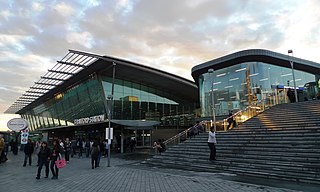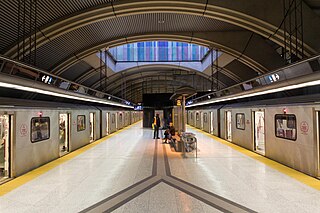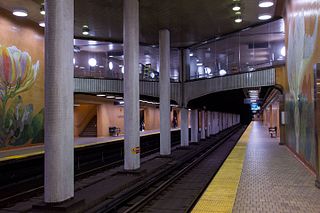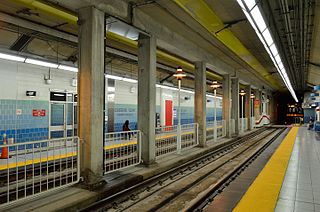
A tunnel is an underground or undersea passageway. It is dug through surrounding soil, earth or rock, or laid under water, and is perfectly enclosed except for the two portals common at each end. A pipeline is not a tunnel, though some recent tunnels have used immersed tube construction techniques rather than traditional tunnel boring methods.

Crossrail is a completed railway project centred on London. It provides a high-frequency hybrid commuter rail and rapid transit system, known as the Elizabeth line, that crosses the capital from suburbs on the west to east and connects two major railway lines terminating in London: the Great Western Main Line and the Great Eastern Main Line. The project was approved in 2007, and construction began in 2009 on the central section and connections to existing lines that became part of the route, which has been named the Elizabeth line in honour of Queen Elizabeth II who opened the line on 17 May 2022 during her Platinum Jubilee. The central section of the line between Paddington and Abbey Wood opened on 24 May 2022, with 12 trains per hour running in each direction through the core section in Central London.

Stratford is a major multi-level interchange station serving the district of Stratford and the mixed-use development known as Stratford City, in the London Borough of Newham, East London for London Underground, London Overground, Docklands Light Railway (DLR) and Elizabeth line services. National Rail services also operate on the West Anglia Main Line and the Great Eastern Main Line, 4 miles 3 chains (6.5 km) from Liverpool Street.

Line 1 Yonge–University is a rapid transit line of the Toronto subway. It serves Toronto and the neighbouring city of Vaughan in Ontario, Canada. It is operated by the Toronto Transit Commission, has 38 stations and is 38.4 km (23.9 mi) in length, making it the longest line on the subway system. It opened as the "Yonge subway" in 1954 as Canada's first underground passenger rail line and was extended multiple times between 1963 and 2017. As of 2010, Line 1 was the busiest rapid transit line in Canada, and one of the busiest lines in North America. In 2022, it averaged over 670,000 riders per weekday.

Sheppard West is a subway station on Line 1 Yonge–University in Toronto, Ontario, Canada. The station, which is located near the intersection of Sheppard Avenue West and Allen Road, opened in 1996 in what was then the City of North York, and the commuter parking lot opened in July 2005. It was the northwestern terminus of the line for over two decades, until the opening of the Toronto–York Spadina Subway Extension on December 17, 2017.

Eglinton West is a subway station on Line 1 Yonge–University in Toronto, Ontario, Canada. It is located in the median of Allen Road on the north side of Eglinton Avenue West.

St. Clair West is a subway station on Line 1 Yonge–University in Toronto, Ontario, Canada. It spans the block north of St. Clair Avenue West to Heath Street, between Bathurst Street and Tweedsmuir Avenue. The station serves the local communities of Forest Hill South, Humewood, Bracondale Hill and Casa Loma.

Dupont is a subway station on Line 1 Yonge–University in Toronto, Ontario, Canada. It is located on Spadina Road at Dupont Street in The Annex neighbourhood of the city. Wi-Fi service is available at this station.

Spadina is a subway station on Line 1 Yonge–University and Line 2 Bloor–Danforth in Toronto, Ontario, Canada. It is located on Spadina Road, north of Bloor Street West. It is one of only three stations open overnight, along with Queens Quay station and Union station. Wi-Fi service is available at this station.

Union is a subway station on Line 1 Yonge–University of the Toronto subway in Toronto, Ontario, Canada. It opened in 1954 as one of twelve original stations on the first phase of the Yonge line, the first rapid transit line in Canada. It was the southern terminus of the line until the opening of the University line in 1963, and is today the inflection point of the U-shaped line. Along with Spadina station and Queens Quay station, it is one of three stations open overnight to support late-night streetcar routes.

Queens Quay is an underground streetcar station of the Toronto streetcar system in Toronto, Ontario, Canada. Along with Spadina station and Union station, it is one of three stations open overnight to support late-night streetcar routes. It is the only underground streetcar station that is not part of or connected to a Toronto subway station. It was opened in 1990 as part of the former Harbourfront LRT route. The station is now served by the 509 Harbourfront, 510 Spadina daytime routes and the 310 Spadina night route.

Finch West is a subway station on the Line 1 Yonge–University of the Toronto subway. It is located under Keele Street, north of Finch Avenue West. When Line 6 Finch West opens in the fourth quarter of 2024, it will serve as the eastern terminus of that line.

Line 5 Eglinton is a light rail line that is under construction in Toronto, Ontario, Canada. Owned by Metrolinx and operated by the Toronto Transit Commission (TTC), the line will be part of the Toronto subway system as its fifth route. The first phase of the 19-kilometre (12 mi) line will include 25 stops along Eglinton Avenue, from Mount Dennis station mostly underground to Laird station, after which it will run predominantly at-grade within the street's median to Kennedy station, where it will connect underground with Line 2 Bloor–Danforth. The second phase, a 9.2-kilometre (5.7 mi) westward extension from Mount Dennis, will run mostly underground or elevated to Renforth station, with seven new stations.

Rapid transit or mass rapid transit (MRT), commonly referred to as metro, is a type of high-capacity public transport that is generally built in urban areas. A grade separated rapid transit line below ground surface through a tunnel can be regionally called a subway, tube, or underground. They are sometimes grade-separated on elevated railways, in which case some are referred to as el trains - short for "elevated". Unlike buses or trams, rapid transit systems are railways, usually electric, that operate on an exclusive right-of-way, which cannot be accessed by pedestrians or other vehicles.

Knyaginya Maria Luiza Metro Station is the 21st station to open on the Sofia Metro in Bulgaria. It is situated near the Nadezhda road junction in the northern part of Sofia, at the intersection of Maria Luiza Boulevard and Gen. Stoletov Blvd. It opened on 31 August 2012 and is also known as the fifth station on the M2 line of the metro. It was also the first station on the path of the TBM, which worked on the section between stations 5-II and 9-II, entirely constructed by the Turkish company Doğuş Construction, part of Doğuş Holding. The station is a shallow triple-span station with two rows of concrete and steel columns. It serves two central tracks and two side platforms. There are four street entrances, two on each side of the boulevard after which the station is named. They lead to a central vestibule, directly above the station.

Caledonia is an underground light rail transit (LRT) station under construction on Line 5 Eglinton, a new line that is part of the Toronto subway system. It will be located along Eglinton Avenue between the GO Transit Barrie rail corridor and the entrance to the Westside Mall. This is about 200 metres (660 ft) west of Caledonia Road opposite Blackthorn Avenue.

Airport Central railway station is an underground Transperth commuter rail station at terminals one and two of Perth Airport in Western Australia. The station is located on the Airport line and is one of three stations that were built as part of the Forrestfield–Airport Link project.

Gadigal railway station is an under-construction underground rapid transit station in the central business district of Sydney, Australia. The station is being constructed as part of the Sydney Metro City & Southwest project, and it will be part of the M1 line of the Sydney Metro upon opening in 2024.
The Toronto Transit Commission (TTC) maintains three rapid transit lines and 75 stations on 76.9 km (47.8 mi) of route. There are also two light-rail lines under construction.

Tunnels are dug in types of materials varying from soft clay to hard rock. The method of tunnel construction depends on such factors as the ground conditions, the ground water conditions, the length and diameter of the tunnel drive, the depth of the tunnel, the logistics of supporting the tunnel excavation, the final use and shape of the tunnel and appropriate risk management. Tunnel construction is a subset of underground construction.


















